READY TO GET STARTED?
REQUEST A FREE ESTIMATE
Fill out the form below or call (888) 466-7849 for a free, no-obligation estimate.
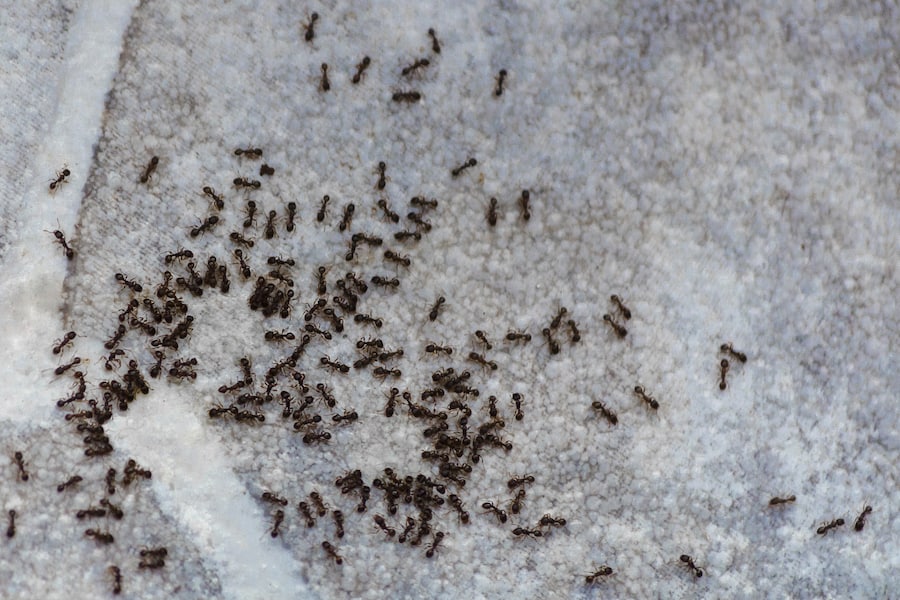
Little black ants are common household pests that are seen throughout the year in the Southeast U.S. but most commonly encountered in larger swarms during warmer months, beginning in late spring and continuing throughout summer, when they’re reproducing. During this time, you may also see winged little black ants (sometimes mistaken for termites). More often, you’ll see trails of these tiny black ants in and around your home, foraging from nests to food source.
Little black ants, like the name suggests, are small, shiny, dark-colored ants ranging from 1/16 – 1/8 of an inch in size. They feed on fruit and vegetable matter, cornmeal and other sweets, oil residue and greases, meat, and even other insects and plants. This makes control of little black ants difficult since most homes provide an ideal food supply in some form. They will make their way into your home in search of warmth, moisture, and/or food. If you see little black ants in large numbers, usually in kitchens and bathrooms, it’s likely an indication of an infestation in wall voids and other areas in and around your home.
To prevent an infestation of little black ants, measures should be taken around the exterior of your home and outside: eliminate or reduce areas conducive to little black ant nests – dark, protected areas – such as rock and wood piles, yard debris, piles of masonry supplies like bricks and lumber, decaying or rotting wood, logs and trees, or any densely wooded areas.
To keep little black ants (and other common pests) out of your home, seal cracks and crevices around windows, doors, foundation, or any exterior walls to prevent entry, keep plants and shrubbery trimmed back, store firewood and other yard debris at least 20 feet away from home’s exterior, eliminate food supplies by keeping a clean home and store all food items in sealed containers, reduce indoor clutter, and most importantly, maintain routine (usually quarterly) pest control service. An exterminator will identify entry points and treat ants in a method that works to eliminate entire ant colonies, which can consist of thousands of little black ants – the only effective, long-term solution to ant control.
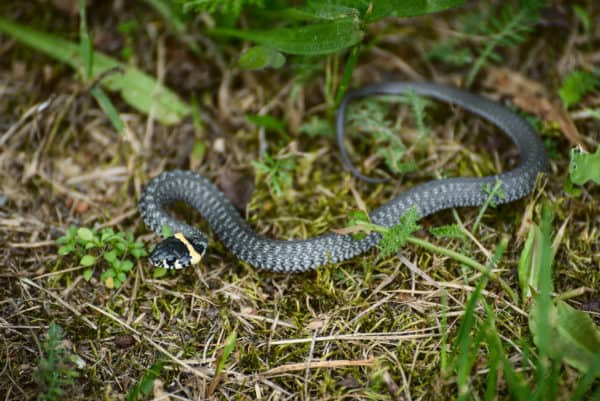
Snakes – scaly, legless creatures that slither into your yard and sometimes even your home. While your first instinct may be to run the other way, there are several benefits to keeping them around. Snakes keep rodent populations under control, with a single snake able to eat 3 to 4 mice at one time. They also eat moles, voles, insects, and even fish.
Snakes are more commonly encountered when temperatures average between 80 and 90 degrees Fahrenheit, usually during the spring and throughout the summer. They are most active in the early morning and late afternoon, as summer temperatures are often too hot for them to be out in during the hottest times of the day. Snake activity will pick back up again in late summer and early fall before they go into hibernation or brumation. Brumation is more common in southern states where the climate is warmer, and snow is less likely. Snakes don’t actually sleep in brumation, but rather their bodies adjust to the lower temperatures, slowing down their metabolism and making them less active. On warm winter days, brumating snakes will sometimes come out to bask in the sunshine, often surprising unsuspecting people with their presence.
While calling a professional pest control company is a guaranteed and safe way to tackle a snake problem, there are also some home remedies you can try to repel snakes. Home remedies to keep snakes away offer several benefits, including:
Snakes are often found in areas where rodents are present, as this is one of their primary food sources. Snakes are also known to eat frogs, birds, moles, voles, insects, and even fish. If you have a problem with any of these animals, consider getting rid of that pest issue first. Once the source of food has been eliminated, snakes will move on in search of another source of food.
Snakes prefer dark, damp places and are known to live and hide in cracks, crevices, and holes. Eliminating these hiding places can help deter snakes from taking up residence on your property. Carefully inspect the exterior of your home and your property and repair any cracks or holes you find. Repair any damaged gutters, piping, and ventilation ducts. Repair or replace any damaged screens on windows and doors. Snakes will also hide in wood piles and compost heaps. If possible, store firewood in sealed, lockable wood boxes. Try to get rid of any piles of wood chip mulch, straw mulch, leaves, etc., that may be collecting on your property.
If your yard or garden is prone to snakes, consider making changes that will deter these pests from coming in. Garden regularly to remove any snake attractants like debris, holes, and overgrowth. Keep the grass cut short of eliminating hiding places for snakes. Consider installing snake-proof fencing made of steel mesh, plastic sheeting, or a catch net. If you do install fencing, make sure it is flush with the ground and angled outward and that it is at least 3 feet high and 4 feet deep. You can also use materials that make it difficult for snakes to slither over, like holly leaves, pine cones, egg shells, and gravel. You can also consider planting snake-repellent plants that provide a natural deterrent. Some common examples include marigolds, lemongrass, and wormwood.
Foxes and raccoons are common predators of snakes. Guinea hens, turkeys, pigs, and cats will also help keep snakes away. If foxes are indigenous to your area, fox urine is a very good natural repellent for snakes when spread around your property.
Snakes have an elevated sense of smell and are ultra-sensitive to odours and fumes. One smell they particularly dislike is smoke. One remedy is to dig a fire pit and let it smoke for several days – covering the embers with moss and leaves can give you the best effect.
Naphthalene is a common ingredient found in many commercial snake-repellent products. It is one of the most common snake repellents. If you don’t want to spend money on a commercial product, naphthalene is also the main ingredient found in mothballs. The smell of naphthalene irritates snakes without harming them. Place mothballs in holes, cracks, crevices, or any other areas around your property where snakes may be a problem. One caveat to using moth balls is they can be toxic and fatal to children or pets if they are ingested, so use caution or avoid using them if you have pets or children in your home.
Powdered sulfur is a great option to repel snakes. Place powdered sulfur around your home and property, and once snakes slither across it; it irritates their skin so they won’t return. Sulfur does give off a strong odour, so consider wearing a mask that covers your nose and mouth when applying it.
Clove and cinnamon oil are effective snake repellents. These should be mixed together in a spray bottle and sprayed directly on snakes for maximum effect. Use caution, as snakes will often run in the opposite direction of the spray. This mixture can also be used in a diffuser indoors as a fumigant, as well.
The sulfonic acid in garlic and onions (the same chemical that makes us cry when we chop onions) repels snakes. Mix these with rock salt and sprinkle them around your home and yard for effectiveness. You can also infuse garlic into any essential oil and use it to fumigate rafters, basements, and other hard-to-reach places.
Snakes dislike the odour of ammonia, so one option is to spray it around any affected areas. Another option is to soak a rug in ammonia and place it in an unsealed bag near any areas inhabited by snakes to deter them away.
Vinegar is effective at repelling snakes near bodies of water, including swimming pools. Pour white vinegar around the perimeter of any body of water for a natural snake repellent.
Create a mixture of snake-repellent lime and hot pepper or peppermint and pour it around the perimeter of your home or property. Snakes don’t like the smell of the mixture, and the fumes are also itchy on their skin.
If home remedies to keep snakes away aren’t working, consider calling a wildlife control company for snake removal, snake prevention recommendations, and possibly other exterminating services like rodent control that could be contributing to the issue.
A Step-By-Step Lawn Care Guide
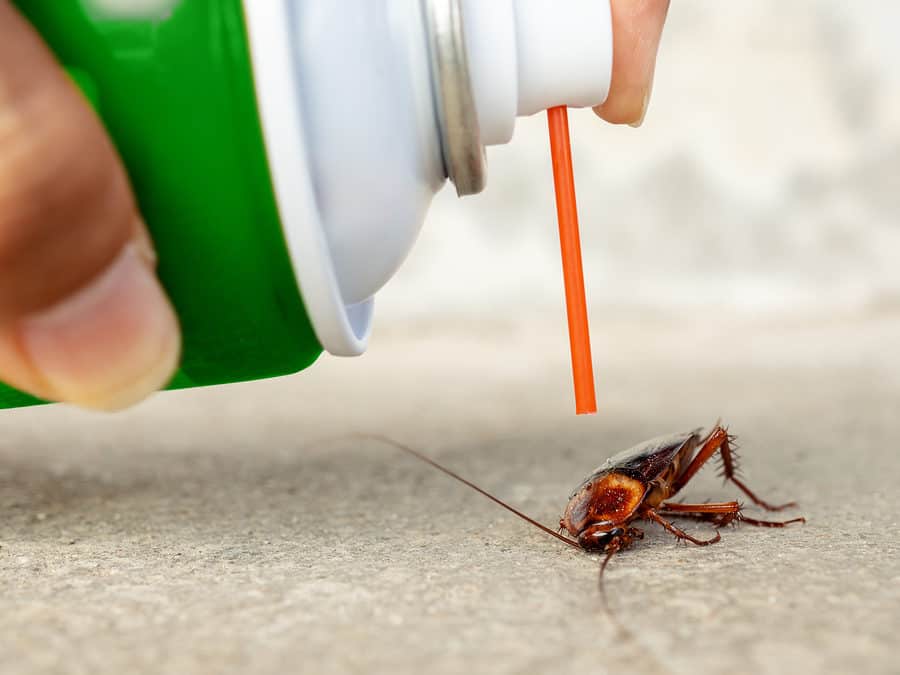
With the recent focus on going “green” and harmful impacts on the environment, many people are ramping up their efforts to establish eco-friendly practices in both the workplace and at home. Efforts to recycle, reduce energy usage, and limit carbon emissions are all common ways to make a positive impact on the environment. One area that isn’t often thought of in the “green” movement is pest control. Green pest control is an environmentally friendly alternative to traditional pest control that is commonly used in areas that house the young, the elderly, the immunocompromised, and pets. But what is the difference between the two?
Traditional pest control provides most of the same benefits as green pest control but utilizes synthetic chemicals to eliminate and control pest populations. These chemicals are used sparingly, however, with just enough used to target the specific pest issue.
Green pest control, on the other hand, eliminates common household pests with the lowest environmental impact possible. This is achieved with ingredients derived from flowers, plants, and natural elements rather than harsh chemicals. Green pest control has proven to be just as beneficial as traditional pest control methods. Green pest control uses preventative measures combined with purposeful application of natural products.
Green pest control also utilizes a 5 step Integrated Pest Management (IPM) process which is an “effective and environmentally sensitive approach to pest management that relies on a combination of common sense practices.” The 5 steps of an IPM program include Plan, Inspection, Pest Identification, Ongoing Perimeter Protection, and Continuous Communication.
NorPest Green is Northwest’s quarterly pest control program performed by only the highest-trained professionals, using high-quality, non-toxic products derived from botanicals. We customize a plan based on your needs, so you can be sure your home is healthy and your family and pets are protected. NorPest Green also comes with a service guarantee meaning we come back in between regular scheduled pest control visits, if needed, at no additional cost to you.
Pests are a nuisance and can be detrimental to both your home and your health. Regardless of whether you choose a traditional pest control service or a green pest control service, protecting your family is of the utmost importance. Contact a professional pest control company like Northwest for a free pest control estimate.
German Roaches vs American Roaches: What’s The Difference?
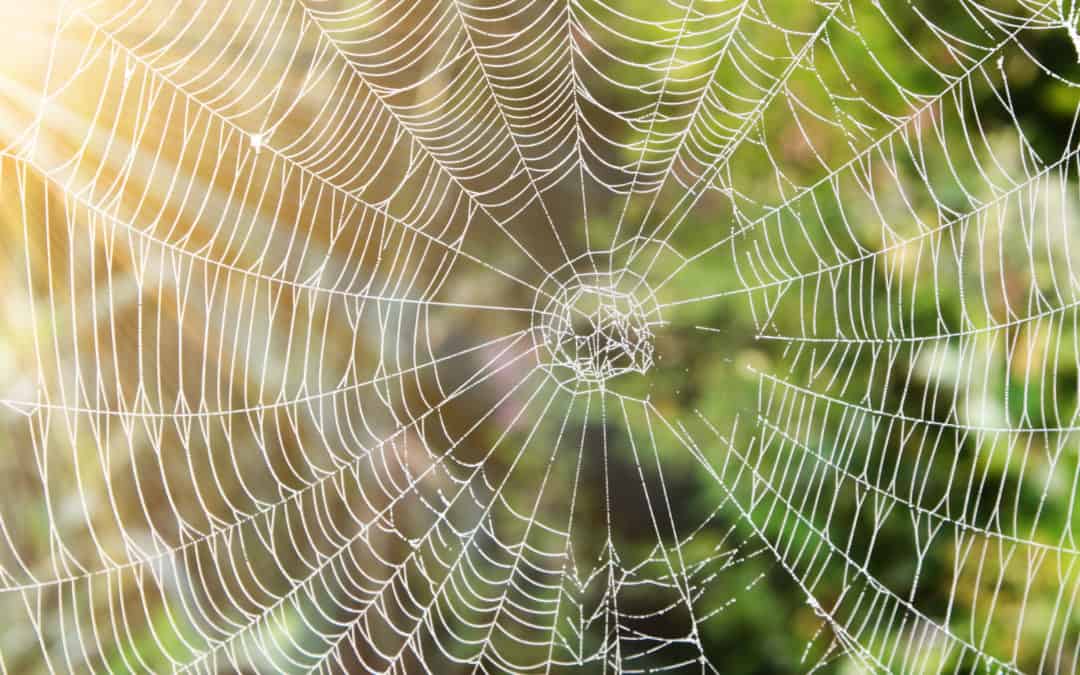
The climate of Georgia (and the southern United States in general) provide the ideal environment for several species of spiders. The humidity and subtropical conditions provide just the right setting for these pests to thrive. Almost all species of spiders found in the United States pose no threat to humans. In fact, of the 38 known species of spiders in Georgia, only 2 are harmful to humans. Here are 10 of the most common spiders found in Georgia and the threat they may pose to you and your family.
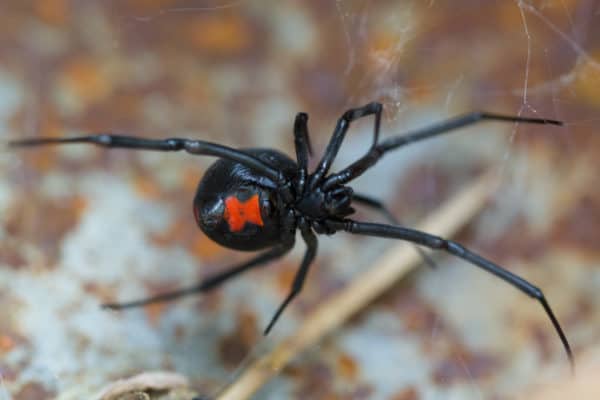
Black widow spiders are black and shiny in color with a prominent red hourglass shape on their back. They are most often found around woodpiles and can easily access your home by hitching a ride inside on your firewood. They are also found in common places around your home where they can be undisturbed like eaves, empty boxes, and even shoes that are stored away and never worn. Black widows can be harmful to humans if bitten. While males rarely bite, females have been known to be aggressive especially when they are guarding their eggs. Black widow bite symptoms include fever, elevated blood pressure, nausea, and sweats. Death is uncommon after a black widow bite, especially if treatment is received quickly. In fact, there has not been a black widow related death in the United States in over 10 years.
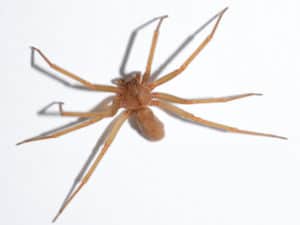
Brown recluse spiders are light to dark brown in color (hence their name) with a signature dark brown violin shape on their backs. They are commonly found outdoors in debris and woodpiles. If they are found indoors, they are usually found underneath furniture, inside storage bins, and in dark recesses like baseboards. They are often found hiding out in closets, attics, and crawlspaces. Brown recluse spiders will bite when on the defensive. These bites are very painful and often leave an open, ulcerating sore that must be treated by a medical professional. Other symptoms include fever, restlessness, and difficulty sleeping.
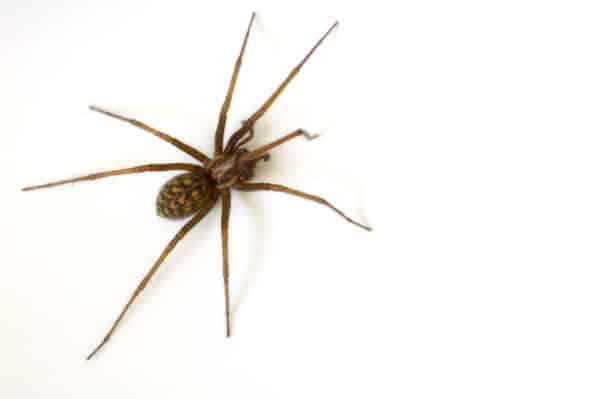
House spiders vary in color but most are yellow to brown in color with elongated abdomens. They are most often found inside homes (hence their name) usually in ceiling corners, under furniture, and inside closets, basements, garages, and crawlspaces. When outdoors, they are often found around windows, under eaves, and near light sources. While they can be a nuisance to have in your home, they don’t pose any threat to humans. Because of the low humidity and fewer insects in modern homes, house spiders are becoming less common in houses and more likely to be found in garages, sheds, barns, and warehouses.
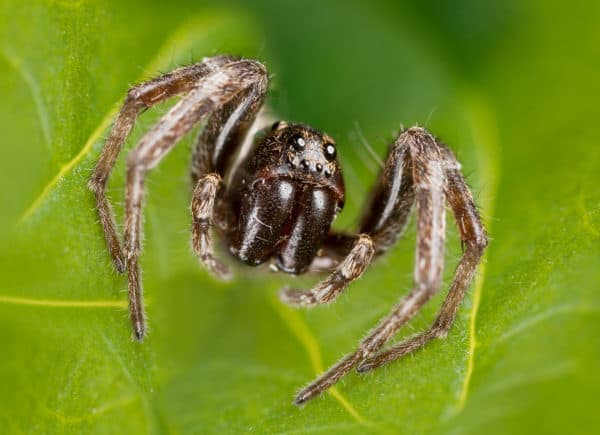
Wolf spiders are typically dark brown in color with pale markings or stripes. Their legs are long and spiny and most have hair on their bodies. When indoors, wolf spiders typically stay on or near the floor, especially along walls and under furniture. They often come inside on firewood. When found outside they are usually found under firewood piles, leaves, yard debris, and stones and will often hide in these places during the day. While wolf spiders can bite, these incidents are rare and they don’t pose a significant threat to humans. Wolf spiders are unique in that they don’t capture their prey in webs but rather by chasing them down using their speed.
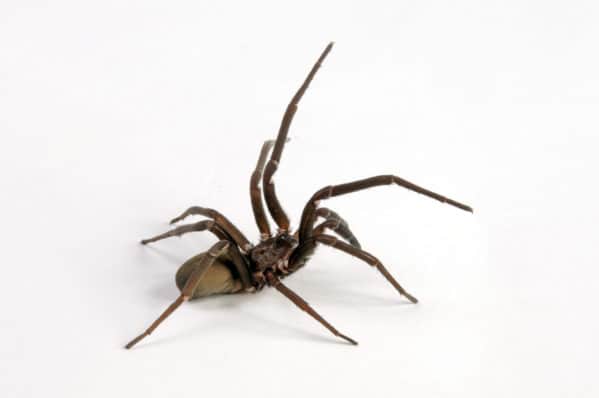
Crevice spiders have similar shapes and coloring as brown recluse spiders and are, in fact, often mistaken for them. While they do have the same light to dark brown coloring and similar body shape, they do not have the signature violin-shaped markings that the brown recluse has. They are often found in corners and crevices which is where their name comes from, typically located in ceiling corners, along baseboards, and in window frames. They can be beneficial to homeowners as they eat common household pests like flies, roaches, beetles, and wasps. While they can bite if threatened, this is very rare and they do not pose a significant threat to humans.

The yellow garden spider is a large, black and yellow spider that is known for spinning large circular webs. Females are black with bright yellow patches on their abdomens. Males are smaller with less yellow coloring on their abdomens. They are typically found outdoors in sunny areas with plants on which they can anchor their webs (hence their name). Garden spiders don’t pose a threat to humans (other than the chance of walking through their sometimes significantly large webs) but they do produce venom that is harmless to humans, but helps to immobilize prey like flies, bees, and other flying insects that are caught in the web.
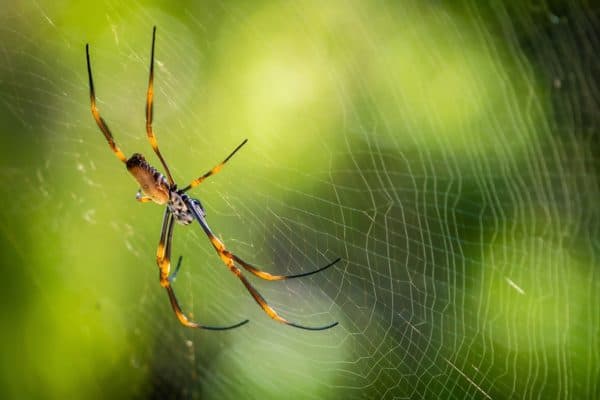
Orb weaver spiders can vary in size and coloring but are often mistaken for brown recluse spiders. They are known for creating distinctive sheet webs with an escape tunnel at the rear. These webs can be up to 3 feet in diameter. Many orb weavers are brightly colored, have hairy or spiny legs and a relatively large abdomen. Orb weavers are typically nocturnal spiders and many species will build or do repair work on their webs at night. Orb weavers do not pose a threat to humans. They will bite if cornered but the bite is comparable to a bee sting.
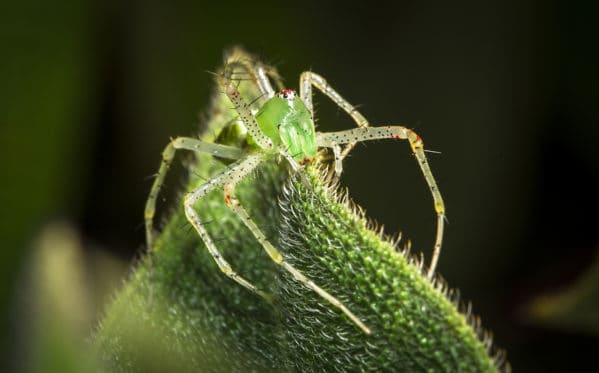
The lynx spider is bright green in color, resembling the color of a plant leaf. They will also sometimes have orange on their legs and black dots, as well. Their legs are covered in long black spines. They are very quick in movement and are able to jump large distances to capture their prey. They are often found in open fields, especially those with tall grass surroundings. The lynx spider can be quite useful in agricultural management. They will bite if on the defensive but they do not pose a significant threat to humans.
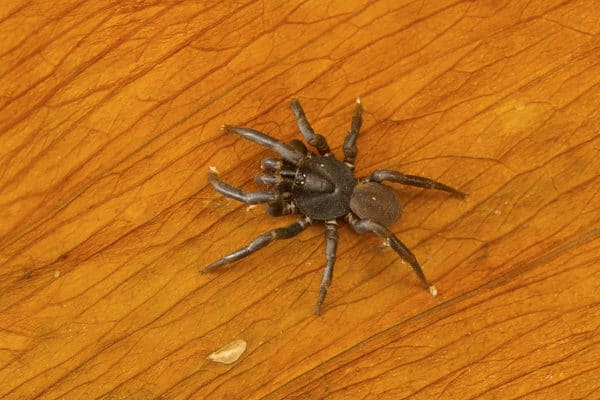
The trapdoor spider is a large, hairy spider that can range in color from yellowish brown to reddish brown to black. They have powerful jaws and sharp fangs. Trapdoor spiders get their name from the burrows they construct with a cork-like trapdoor made of soil, vegetation and silk. They spend most of their lives underground and usually hunt at night. Trapdoor spiders are not aggressive and, in fact, are often timid when confronted. They can bite but this is rare. They do not pose a significant threat to humans.
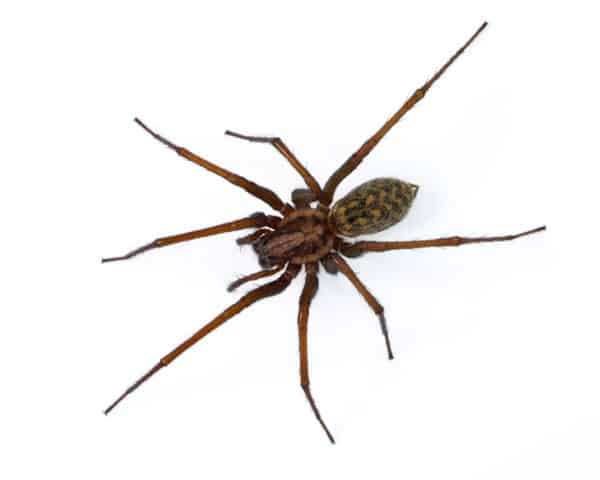
The hobo spider is light to medium brown in color with a down the center with an oblong abdomen. Hobo spiders build funnel webs that open at both ends with one end expanding outward into a broad, slightly curved sheet. Mating season is from June to October and the wandering of males in search of a mate brings them in to much more contact with humans than females. Therefore, male hobo spiders are responsible for more bites than females because of this increased contact with humans. Their bites, however, do not pose a significant threat to humans. Hobo spiders can be found in almost any habitat. They are commonly found in places with holes, cracks, or crevices. They are terrible climbers and are rarely found above ground level. They prefer dark, moist environments like basements, crawlspaces, and window wells.
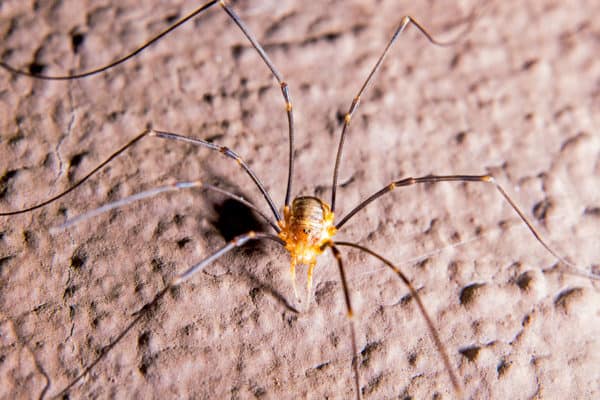
Contrary to popular belief, Granddaddy Longlegs are not, in fact, spiders; they actually belong to a group of arachnids known as harvesters or harvestmen. The predominant feature of harvesters including the granddaddy longlegs is legs that are exceptionally long in relation to their body size. Harvesters are usually seen around harvest time – hence their name. Just in North America alone there are about 150 species of granddaddy longlegs. They use their extremely long legs to catch their prey rather than building webs. Granddaddy longlegs are not poisonous or venomous and do not pose any threat to humans.
Whether they are dangerous to humans or not, most people would prefer to keep spiders out of their homes as much as possible. The best way to prevent spiders from taking up residence in your house is to get rid of any areas where they can hide. Spiders are more common in the fall and winter as they make their way indoors in search of food and warmth. Keep your garage, attic, and basement clear and decluttered. Try not to leave shoes and clothing on the floor. Seal any cracks and crevices around your home. Consider enclosing your crawlspace and sweep down any cobwebs that appear. As always, if you suspect you have a spider problem, contact a professional pest control company who can help identify the type of spiders you have and provide you with a thorough evaluation and treatment and prevention plan.
How Much Damage Can Termites Really Cause?
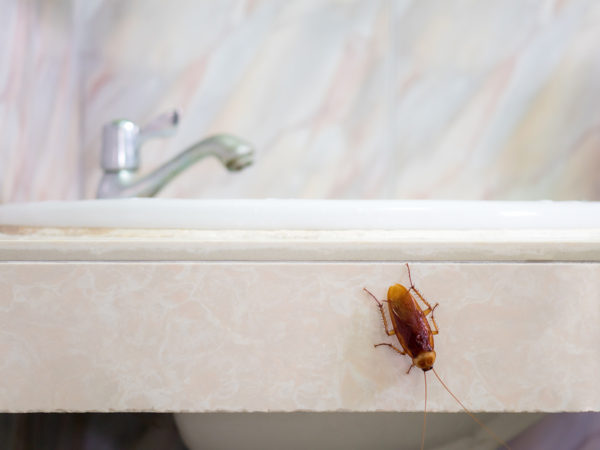
Take out the trash regularly; keep your house spotless; store your food in airtight containers: these are just a few of the things you can do to prevent pests from coming into your home. So what attracts cockroaches to a clean house? Cockroaches are extremely versatile pests. They have a very wide-ranging diet and will eat just about anything you can imagine. They have highly tuned water-finding senses and are experts at hiding. All of these adaptations allow them to survive in just about any environment. Roaches also pose health concerns to humans. They are known to carry diseases and can trigger allergies and asthma. They are also extremely hard to get rid of once you have cockroaches in the house. But how do cockroaches get in your clean house?
Some areas are more prone to cockroaches than others. The southeastern United States, especially Georgia, Florida, and Alabama, are home to a large population of American cockroaches (also known as palmetto bugs). If you live in these areas you can expect to see these pests in your home despite cleaning on a regular basis. Unlike German cockroaches, American cockroaches aren’t associated with unsanitary conditions. They may enter your home through a gap in a window seal or through a door that is left open for a prolonged period of time.
Roaches come into your home in search of three things: food, shelter, and water. They have also developed the ability to use even the smallest of openings as an entryway into your house. They can come in through cracks in the exterior walls, dryer vents, or even the gaps between walls and floors. Perform a thorough evaluation of the exterior of your home and seal any entry points you find.
Roaches need moisture to survive and this search for water will bring them into even the cleanest of homes. Leaky pipes and faucets are one of the most common attractants for cockroaches and is one of the main reasons you often see them in bathrooms, kitchens, and laundry rooms. They will also hide out under refrigerators and air conditioning units to indulge in their condensation, and even drink from pets’ water bowls when left out overnight. Roaches love places that are dark and undisturbed so you can often find them in basements, in the dark corners of cabinets, and underneath large appliances, especially those that use water.
Roaches will seek out food sources wherever they can find them. Despite your best efforts to keep your kitchen spotless, these resilient pests will make do with just about anything to eat. In fact, they have been known to feast on cardboard, wallpaper paste, book bindings, grease, leather, soap, and even human hair. They can often be found hiding out in stacks of cardboard in your attic and garage, books that you’ve stored away for extended periods of time, and even behind pictures that have been hanging on the walls.
While these areas may not be in need of repair or even in plain sight, they can attract roaches and need to be addressed to prevent roach infestations. Roaches have been known to hide out in the spaces between outside doors and floors. They can get into your home through window screens that aren’t flush with the frame or that have rips or tears in them. They can also get in around air conditioning units that don’t fit properly in windows, and into trash cans that aren’t cleaned regularly, even the ones in your bathrooms.
Roaches will come into your yard in search of the same things as your home: food, shelter, and water. You can harbor as many roaches in your yard as you do in your home. Any standing water in places like bird baths, flower pots, and gutters will attract cockroaches. Compost and wood piles provide food and shelter. Trash and recycling bins provide an excellent food source. Leaf litter, dense vegetation, and mulch or pine straw provides ideal hiding places.
Roaches are versatile pests that are extremely hard to get rid of once they get into your home. There are some roach prevention steps you can take to help keep them from invading your house:
It can be frustrating to work hard at keeping your house clean and still have issues with roaches. If you have a roach problem or if you want to get a prevention program started before they become a problem, call a professional pest control company who can provide you with a customized pest control program using only the most innovative and advanced pest products and equipment available. Give us a call or request a free estimate to get started.
How Much Does A Termite Inspection Cost?
German Roaches vs American Roaches: What’s The Difference?
Where Are All of These Roaches Coming From?
Is Your Hotel on the Bed Bug Registry?
Winter Lawn Care: Is Your Grass Prepared For Spring?
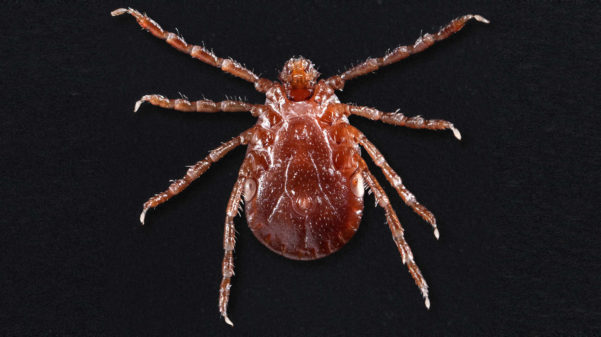
For the first time in fifty years, the U.S. has its first known invasive tick.
The longhorned tick, first discovered in November 2017, has been found in New York, Pennsylvania, Maryland, Virginia, West Virginia, North Carolina, and Arkansas. Professionals have had unsuccessful attempts to exterminate this particular species, leading it to be classified as an invasive species.
Normally an animal-attracted pest, the longhorned tick has been known to carry and transmit diseases like Lyme, spotted fever, and Severe Fever with Thrombocytopenia (SFTS). SFTS symptoms include fever, vomiting, multiple organ failure, along with many other symptoms. Fortunately, of the ticks tested here in the U.S., no human diseases have been detected.
As always, use the normal precautions towards tick exposure:
Continuing to follow these precautions will help to prevent tick exposure for you and your family members.
How Much Does a Termite Inspection Cost?
Pest Control for Basements and Attics
Wildlife Control: What Threat do Rodents Pose to Humans?
Exterminating: Rain and the Bugs it Brings?
Termite Treatment: Termites vs Flying Ants

With the start of a new year, you may have begun to purge your home of unnecessary items or mapped out a major cleanup day. While the most lived in rooms are probably on your radar – the kitchen, bathroom, living room, and bedrooms – areas like your basement and attic can become catch all-areas or forgotten altogether. These neglected spaces are then susceptible to pest invasions and other home issues.
These tips are only part of your healthy home journey. Schedule a pest inspection with a licensed exterminator, who can identify current pest issues, potential pest threats in the future, and provide a personalized pest control plan for ongoing prevention.
Pest Control: Where Do Pests Go In The Winter?
Wildlife Control: Sneaky Wildlife – Possums and Raccoons
Lawn Care: 10 Ways To Care For Your Lawn In Extreme Heat
Termite Control: 10 Things You Didn’t Know About Termites
Is Green Pest Control Worth The Investment?

Green pest control provides an eco-conscious option to traditional pest control and is especially beneficial in homes and businesses that house the young, the elderly, pets, and those with compromised immune systems or allergies. But are they really effective?
The answer is yes. Green pest control typically utilizes botanical and/or earth-based pesticides and a targeted approach when applying them, focusing on eliminating and controlling pest populations through both preventative measures and purposeful product application, based on your specific pest issues.
One important component of any green pest control program is Integrated Pest Management (IPM). IPM doesn’t just focus on eliminating pest populations but also on identifying and getting rid of the environmental factors that are allowing the pests to procreate and thrive, as well as preventative measures to prevent re-entry. IPM can actually cut back significantly on the amount of pesticides used in treatments (by more than 90%!).
Once green pest control companies identify the problem pests and decide that action is required, there are several methods that are used to eliminate them:
Once you make the decision to invest in a green pest control program, contact an exterminator near you, and they will provide you with the following:
You May Also Be Interested In:
Wildlife Control: Unusual Winter Wildlife
What Are Your Termite Treatment Options?
Pest Control: Does The Weather Affect Pests?
Exterminating: The Last Of The Creepy Crawlers
Fall Lawn Care

It’s that time of year again! 2018 is winding down and the time has come to start thinking about your New Year’s resolutions. If you’re like most of us, saving more money and having less stress definitely make our list of resolutions. What we don’t often think of as a resolution is pest-proofing your home. In fact, pest-proofing can actually save you money and stress in the long run. Most pests are seasonal – spiders and rodents are common in the winter months while mosquitoes are prevalent in the warmer months. There are, however, steps you can take any time of year to prevent pests year-round. Check out these 8 tips to pest-proof your home this New Year’s.
As the holiday season winds down, we’re now faced with the sometimes arduous task of taking down and putting away our holiday decorations. Now is the time to go through them and get rid of any broken, worn out, or outdated decorations before you put the boxes away. Store your decorations in plastic containers that seal tightly rather than cardboard. Store your containers off the floor if possible. Make sure to properly dispose of live trees, wreaths, garland, etc.
Pests come into our home for 3 reasons: shelter, food, and water. Keeping your home, and especially your kitchen, clean can eliminate 2 of those reasons. Clean your kitchen after each meal, wiping up crumbs and spills immediately. Store food, including pet food, in air tight containers. Sweep, dust, and vacuum regularly. Dispose of your garbage regularly and use garbage cans with lids.
Pests often only need a very tiny crack or gap to gain access to your home. Inspect all of the exterior walls of your home for cracks and gaps and seal them tightly with caulk. Be especially careful around the places where utilities and pipes come into the home. Use door sweeps on all your exterior doors to seal the gap between the floor and the door. Use screens on doors and windows and make sure they are in good repair.
There are lots of pests that like to hang out in the woodpile, hitching rides into your home on the logs. Keep your firewood stored at least 20 feet away from your home and elevate it if possible. Make sure to brush it off before you bring it indoors.
Pest-proofing isn’t just limited to the inside of your home. Pest-proofing the outside of your home is also critical. Get rid of any dead bushes and branches and rake up all the leaves from your yard. Clean your gutters or consider installing gutter guards to eliminate clogs and standing water. Trim your bushes and trees back so they aren’t touching the sides of your home.
Many pests like cockroaches are attracted to water. Check your home for leaks, even those that don’t seem like a big deal like dripping faucets and loose fixtures. Consider enclosing your crawlspace to reduce moisture under your home.
You don’t have to wait for spring to spring clean! Check that resolution off your list a few months early. Start at the lowest level of your home and work your way up room by room. Clear the floors, dust, sweep, mop, vacuum, clean out closets and drawers and get rid of anything you don’t need.
If this all seems to overwhelming or if you already have a pest problem in your home, call a professional pest control company. The pros can assess your home from top to bottom and identify any sources of pest problems and provide you with a thorough evaluation and set you up with a treatment and prevention plan.